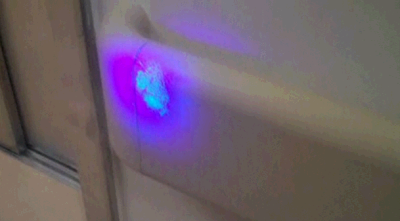Multiple C. difficile outbreaks throughout 2011 made headlines and caught the attention of consumer watchdogs. One investigation led by the consumer reports program CBC Marketplace looked into the unsanitary conditions at a number of hospitals as a major cause of the outbreak.
Multiple C. difficile outbreaks throughout 2011 made headlines and caught the attention of consumer watchdogs. One investigation led by the consumer reports program CBC Marketplace looked into the unsanitary conditions at a number of hospitals as a major cause of the outbreak.
CBC Marketplace visited 11 hospitals in early 2012 with hidden cameras. The team applied a glow gel to handrails, doors, and other high touch areas, and returned 24 hours later to test if the surfaces had been cleaned by observing whether the glow gel had been removed. The glow gel is invisible without black light and can only be removed by a combination of friction and cleaning chemicals.
 |
| Glow gel was applied to high-touch surfaces throughout the hospital. View the CBC Marketplace video. |
When the cameras returned a day later, it was discovered that many of the surfaces had been left untouched by the cleaning team. These high touch surfaces could act as a harbour for bacteria and spread the infection to anyone who pressed an elevator button or used a washroom.
Hospital Acquired Infections are currently the second most common adverse event affecting health care facilities. Hospital Acquired Infections including C. difficile, MRSA, and E. coli are common in the United States, with over 2 million cases reported each year and over 100,000 deaths annually.
The Cost of Hospital Acquired Infections
In the United States, Hospital Acquired Infections cost over $5 billion each year, and high readmission rates can further increase this cost. Patients affected by Hospital Acquired Infections including MRSA or C. difficile are 40% more likely to be readmitted within a year than other patients, which can add up to $26 billion in additional health care costs each decade.
Starting in October 2012, Medicare will begin to penalize hospitals with higher than expected readmission rates in the first month after a patient’s discharge. As a result, hospitals should continue to focus on improving cleaning procedures in order to reduce the spread of infection within the patient environment.
Infection Control Starts at the Hospital Bed
Since most patients spend the majority of their stay in the hospital bed, it is important to target this area for infection control. Almost 75% of patient rooms are contaminated with MRSA, which can be found on bedrails and other surfaces. The short patient turnover in hospital beds can make it difficult for cleaning staff to thoroughly disinfect and clean a patient room before the next patient arrives.
However, there are 3 ways a hospital bed can improve patient safety and assist cleaning staff with infection control:
- Antibacterial surfaces
- Open architecture
- Non-metal mattress platforms
1. Antibacterial Surfaces
Commonly touched areas of the bed can harbour bacteria and spread infection to patients and hospital workers. To avoid this, bed frames need to be cleaned regularly by cleaning staff, but this can sometimes be overlooked.
Antibacterial solutions implanted in the hospital bed’s surfaces can help to improve hygiene in patient rooms by eliminating most of the harmful bacteria that can cause infection. These antibacterial solutions kill 99.9% of MRSA and E. coli and reduce the spread of bacteria in the patient room. Antibacterial bed frames can assist cleaning staff in keeping patients safe and can be a line of defense against the spread of Hospital Acquired Infections.
2. Open Architecture
Nooks and crannies on hospital bed frames can often make cleaning a challenge, leaving untouched areas prone to bacteria growth. A hospital bed that features open architecture and accessible undercarriages can help staff clean the often hard-to-reach areas of a hospital bed. Cleaning efficiency can be improved with visibility and easier access to all areas of the bed that can save time and improve infection control.
3. Non-Metal Mattress Platforms
When a patient lies in bed, a mattress can experience temperature fluctuations from body heat. Metal mattress platforms do not adapt well to these temperature changes and can “sweat,” which allows moisture to build between the deck and the mattress itself. This moisture can promote bacteria growth over time and can lead to serious complications including mold, mildew, and unsatisfactory equipment hygiene which can spread to the patient.
It can be difficult for maintenance staff to regularly clean the metal mattress platform and eliminate the moisture build-up that can house harmful bacteria. With a change in mattress platform material, this bacteria growth can be slowed, and patient safety can increase. Non-metal mattress platforms made of fibre-composite material can adapt to temperature fluctuations and keep the surface dry and clean.
Switching to a different mattress platform material can improve patient safety and help cleaning staff to reduce the risk of infection.
Conclusion
Eliminating the spread of bacteria at high touch patient areas with improved cleaning processes can help minimize Hospital Acquired Infections. Though constant patient use can make hospital beds a challenging area for cleaning staff, using a hospital bed that can help combat the spread of infection can improve patient safety and can help reduce hospital readmission rates.